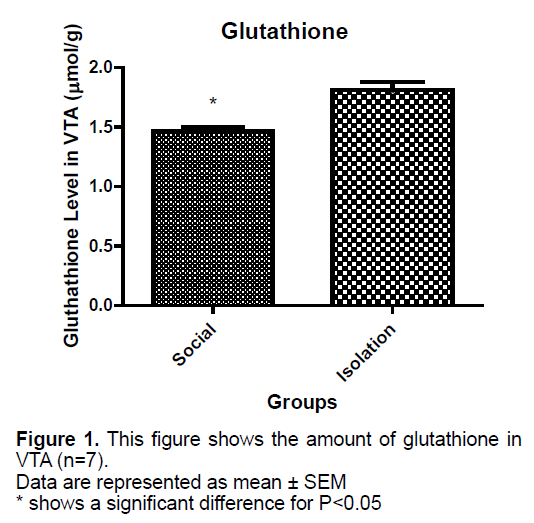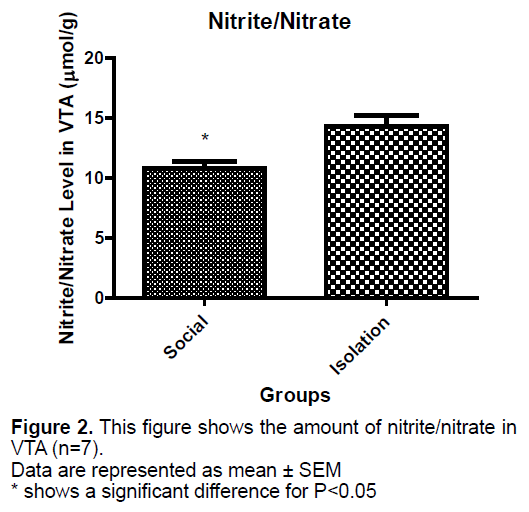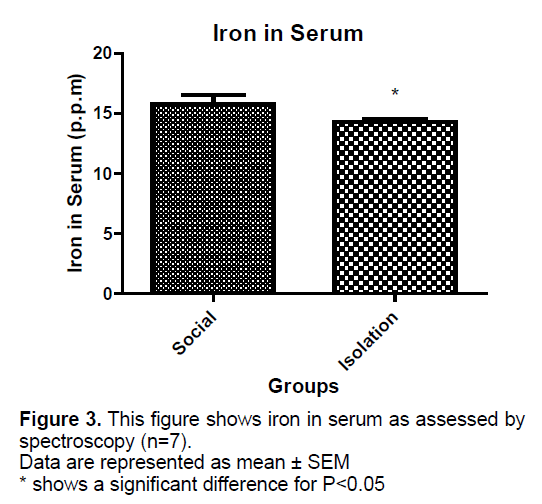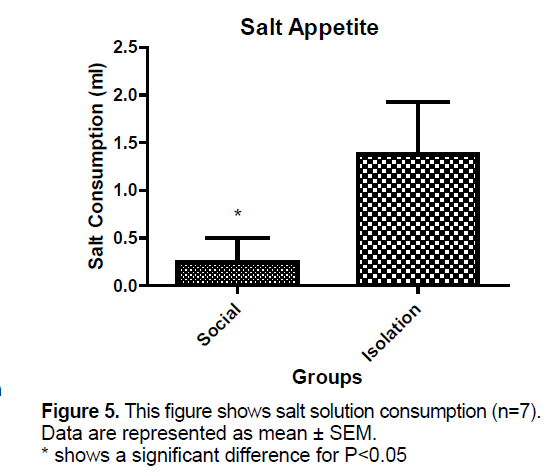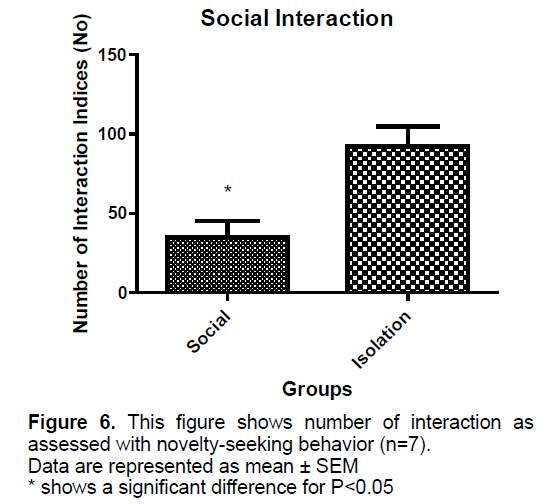Sociality Influences Oxidative Stress Indices in Ventral Tegmental Area and Tendency for Drugs in Male Rats
Hamidreza Famitafreshi, Morteza Karimian
Department of Physiology, Tehran University of Medical Science, International Campus, Tehran, Iran.
Received date: April 14, 2017; Accepted date: May 17, 2017; Published date: May 24, 2017
Citation: Famitafreshi H, Karimian M. Sociality Influences Oxidative Stress Indices in Ventral Tegmental Area and Tendency for Drugs in Male Rats. Electronic J Biol, 13:2
Abstract
Introduction: Ventral tegmental area is a region in reward circuit that influences addictive behaviors. Oxidative stress status is an important regulator of neuronal function. The aim of this study is to show that sociality can influence ventral tegmental area (VTA) function through modulation of oxidative stress status. Methods and materials: In this study 21 male Sprague-Dawley rats weighing 200-250 g were randomly divided into two groups: social and isolation. After 14 days of isolation and sociality rats were examined for salt solution consumption, sucrose intake, and novelty seeking behavior. Then rats were anesthetized and sacrificed for assessing oxidative stress (OS) indices for glutathione and nitrite/nitrate. Iron in serum was assessed with atomic spectroscopy. Results: Glutathione and nitrite/nitrate were increased in isolated rats compared to social rats. Also, novelty seeking behavior, consumption of salt solution and sucrose were increased in isolated rats compared to social rats. Iron was reduced in isolated rats compared to social rats. Conclusion: In isolation markers of oxidative stress indices in VTA for glutathione and nitrite/nitrate were increased along with bad prognosis in behavioral tests. Thus it seems isolation increases tendency for drugs and glutathione and nitrite/nitrate were increased to neutralize the harmful behaviors.
Keywords
Glutathione; Nitrite/Nitrate; Iron; Social; Isolated; Sucrose; Salt; Novelty seeking behavior.
1. Introduction
Addiction is a complex disease with many sideeffects. Many of the problems that addicted people encountered during addiction period is has been attributed to reward circuit that is consisted of ventral tegmental are, nucleus accumbens and ventral palladium [1]. This circuit mainly controls abuse of drugs through regulation of desired euphoric effects that a person expected to get through abusing drugs. However, there is a wide discrepancy between individuals. Since every abuser cannot control himself to progress to everyday abuse. This also can be developing for a variety of reason such as tolerance to euphoric effects, an epigenetic change that is caused by drugs and unknown reasons [2]. On the other hand, an anti-reward circuit that was proposed by some expert is an inhibitory circuit that is inhibiting brain reward circuit in contrast to reward circuit that enhances reward brain circuit [3]. It is proposed that there should be a balance between these two circuits in the brain. It is believed that these two regulatory mechanisms work with each other at the same time in the brain in favor of inhibitory control.
Ventral Tegmental Area (VTA) is a part of reward circuit and an anti-reward circuit that regulates drug abuse [1]. VTA besides its direct role in the control of drug abuse also can influence drug abuse indirectly by projection to related areas such as Amygdala, Cingulate gyrus, Hippocampus, Nucleus Accumbens, Olfactory bulb and Prefrontal cortex [4]. VTA also is the main component of the anti-reward circuit. Previous studies have implicated this area modulation would affect behaviors that are related to the anti-reward circuit [5].
Oxidative stress status especially glutathione has been well documented that is necessary for proper function of neurons [6]. However, in this study, it was assessed in VTA for understating the role OS status in VTA in regulating addictive behaviors.
The aim of this study is to find a relationship between oxidative stress status of VTA and behaviors that are indicative of increased tendency for drugs. And also to show that these behaviors can be modulated by the social environment.
2. Methods and Materials
2.1 Animal care
Male Sprague-Dawley rats 8 to 10 weeks (200-250 g) were obtained from animal house of physiology department of Tehran University of Medical Sciences. Cages were maintained in a temperature-controlled (22 ± 1°C) and humidity-controlled (40-70%) vivarium with a 12 h light/dark cycle (lights on at 7:00 A.M.).
All behavioral testing took place during the lights on the phase of the cycle (specifically, from 11:00 A.M. to 3:00 P.M.) in the experimental room. All rats were habituated to the Tehran University of Medical Science vivarium for at least 7 days before the start of experiments. All experimental protocols were in accordance with the Animal Ethics Committee of Tehran University of Medical sciences Animals. In each group, 7 rats were used. 7 rats were used for inducing pair state.
2.2 Isolation
Isolation of rats was done in small cages (27 × 15 × 21). During isolation, rats had free accessed to food and water. The light-dark cycle was not disturbed [7].
2.3 Pair
The pairing of rats was done in large cages (45 × 15 × 21). During pairing, rats had free accessed to food and water. The light-dark cycle was not disturbed [8].
2.4 Preparation of tissues for assessing oxidative stress markers
Biochemical tests were conducted immediately after last behavioral test. The rats were first sedated with xylazine (10 mg/kg) and anesthetized with ketamine (100 mg/kg) and then the head and neck were dissected out from the rest of body. Then, the VTA area was removed from the spinal cord and froze with liquid nitrogen and then, was kept in -70°C in a refrigerator. It should be noted that because of very small size of VTA area, the VTA area and its surroundings was dissected to get enough tissue to evaluate the biochemical analysis. For the preparation of the final homogenized sample, block from VTA area was prepared and after weighting, they were homogenized with buffer phosphate (1:10/w/v).
2.5 Glutathione assessment
5, 5’-dithiobis-(2-nitrobenzoic acid) (DTNB) was used as the reaction substrate for estimating the amount of reduced glutathione. For performing this experiment Tris buffer, DTNB and methanol were used. 100 μl of homogenized sample was added to the above mixture. The final solution developed yellow color and maximum absorbance was measured at 412 nm with the spectrometer. The final concentration was calculated based on a standard curve that obtained by measuring the absorbance of Tris buffer, DTNB, and methanol at 412 nm. The equation (y=ax+b) was obtained using excel software [9].
2.6 Nitrite/nitrate assessment
Total Nitrite/Nitrate was assessed according to Griess reaction. Simply for performing this experiment n-1 (naphthyl) ethylene diamine (NEDD), sulfanilamide and acid phosphoric all were mixed together. 100 microliter of homogenized sample was added to the above mixture. The final solution developed pink color, and maximum absorbance was measured at 540 nm with the spectrometer. The final concentration was calculated based on a standard curve that obtained by measuring the absorbance of NEDD, sulfanilamide, and acid phosphoric in 540 nm. The equation (y=ax+b) was obtained using excel software [10].
2.7 Assessment iron in serum
For obtaining plasma, after thoracotomy, 5 ml blood was taken from left heart. After coagulation and centrifugation plasma was collected in micro tubes and stored in -70°C. For preparing plasma for analysis of iron level first, they were incubated with 65% citric acid for 2 h. Then for one hour, they were incubated with 65% perchloric acid. The final solution was examined with atomic spectroscopy (Varian- 220-FS-aa) [11].
2.8 Social interaction test
The social interaction test was first introduced by File and Hyde in 1978. This test involves placing a pair of animals in an arena and measuring the amount of time engaged in such behaviors such behavior as grooming, sniffing and fighting. Social interaction has been validated repeatedly as an index of anxiety related disorder [12]. A modification of the standard social interaction test was used to reduce the number of animals needed for the experiment. According to file (1993), the most sensitive procedure is to match up pairs of rats that have the same treatment on the basis of their body weights and then treat the number of interactions by pairs as the unit of measure. During the 5 min session, time spent in social interaction (grooming, sniffing, following) were scored individually for each rat. These interactions assessing sociability of animals. More sociable rats show more interactions. More anxious rats have fewer interactions and instead explore the surroundings. Each indicator of social interaction such as grooming, sniffing, following have 1 score. It means each rat has less anxiety to explore other rats [13].
2.9 Evaluation of NaCl appetite
In this experiment, we removed food for 24 h. After that, we offered NaCl 3% for 1 h. Total consumption was calculated [14].
2.10 Sucrose preference test
The rats were submitted to a 48 h period drinking both sucrose (Sigma-Aldrich) and water for adaptation to sucrose solution taste. For 3 days water was the only available fluid. In the day of experiment rats were placed individually in the test cage, first with no access to fluid for 3 h and then with access to the two bottles, one containing tap water and the other a 1% sucrose solution. Fluid intake was measured by percentage sucrose consumption to total fluid intake [2].
2.11 Statistics
Data analysis and graph preparation were performed with SPSS version 21 ad Graph Pad prism 5. Two- Tailed independent samples t-test was performed. Data was represented as mean ± SEM.
3. Results
The amount of glutathione in VTA region: Amount of glutathione was higher in isolated rats compared to social rats (Figure 1).
The amount of nitrite/nitrates in VTA region: Amount of nitrite/nitrate was higher in isolated rats compared to social rats (Figure 2). Iron in serum: Iron in the serum of isolated rats was reduced compared to social rats (Figure 3). Percentage of sucrose consumption: Consumption of sucrose was higher in isolated rats compared to social rats (Figure 4). The amount of salt consumption: Salt consumption was higher in isolated rats compared to social rats (Figure 5). A number of interactions as an index of novelty seeking behavior and anxiety level: Novelty seeking behavior was increased in isolated rats compared to social rats. Anxiety was reduced in isolated rats compared to social rats (Figure 6).
4. Discussion
In the present study it was shown that 1) isolation influences oxidative stress status of VTA 2) isolation increases sucrose consumption and anxiety level and 3) isolation increases novelty seeking behavior.
Assessment of drug abuse is unpredictable in many conditions. It can be present itself as recreational abuse without complication or increase in both frequency and amount of abuse in every abuse. However, in human studies, it can be assessed by directly assessing the patient. However, in animal studies, it can be assessed by different ways indirectly. The most common are tracking rats in selfadministrators boxes [15]. However in this study for assessing the tendency of rats to drug abuse sucrose preference test and novelty seeking behavior were used. Also, the salt test was used for assessment of sensitization.
Sucrose preference test is mainly used by researchers for assessing anhedonia [16]. However, in addiction studies, some researchers have used this test as the indicator of the efficacy of reward center function. It can be said that the more does the sucrose consume, the more probable the rats desire for drugs abuse. The mechanism underline for this new insight is unknown.
Social interaction test is used for two purposes. In some studies, it has been used for assessing anxiety and in some studies, it has been used for assessing novelty-seeking behavior [12,13]. Decrease in anxiety and increase in novelty-seeking behavior both correlated with an increase in the tendency for abusing drugs [17]. Since the decrease in anxiety level potentiates novelty seeking behavior because less anxious rats are more prone to show novelty seeking behavior.
About the social interaction and its ability to predict the susceptibility of the people to develop high-risk behavior, there is a little controversy in the literature. It is well accepted that more novelty–seeking behavior is an indicator of more tendency for showing high-risk behavior [18]. But the question is this that less anxiety or more anxiety is correlated with novelty seeking behavior. Many studies agree that the anxiety that is assessed by novelty-seeking behavior is different from other experiments such as Elevated Plus Maze (EPM) or the open field [19]. So we hypothesized in novelty seeking behavior that less anxious rats show more tendencies to explore other rats instead of spending more time on surrounding because of more anxiety. So in this manner rats with more interaction are less anxious rats. This is true because in this study isolated rats showed less anxiety in EPM and in open field test pair and isolated rats showed no difference.
About the role of VTA function in addiction there are many questions. Since the exact mechanism that recreational abuse turns to everyday abuse is a mysterious phenomenon. It is better to say that the important question is related to address the unbalance between reward and anti-reward circuit. In this sense sensitization also important because sensitized rats need a lower level of the drug. However, at later stages, this phenomenon resolves and rats come back to compulsive abuse in some rats [20]. In this regard, VTA has been shown to have a vital role.
VTA has a pivotal role in the initiation of compulsive abuse. It has been proposed that depletion of dopamine in VTA stimulates compulsive drug abuse for keeping the homeostasis balance in its normal state. Hence VTA dopamine is necessary for avoiding the initiating drug-seeking behavior. The mechanism for initiation of such behavior is though related to CREB activity within VTA and the resultant upregulation AMPA receptor which impairs the efficacy of VTA for avoiding drug abuse [21].
VTA is a vulnerable area that is affected by some conditions such as stress and social defeat. Both acute and chronic stress can increase drug abuse that is assessed by the self-administrative box [15]. Also, stress causes reinstatement of drug abuse in addicted rats [22]. Social defeat can increase the frequency of drug abuse and binge session [23].
Alternation of VTA function causes mood disorder such as depression. The change that occurred in VTA was the increase in firing rate of neurons [24]. Changes in mood also increase abuse of drugs.
The increase in consumption of salt in different experiments has been shown to be correlated with poor prognosis and the rats that have to consume more salt solution also have more tendency for relapse [25]. However, because of unknown origin of phenomena, it is little hard to describe it exactly. It this study it is postulated that VTA proper function reduces salt intake. Sine maybe increases in antioxidant defense has been occurred for reducing this behavior.
Oxidative stress (OS) can influence dopaminergic neuron in related areas. The most well-known disease is Parkinson disease. There is a verity of mechanisms that can influence OS status in dopaminergic neurons such as mitochondrial dysfunction, DA autoxidation, α-synuclein aggregation, glial cell activation, alterations in calcium signaling, and excess free iron [26].
Besides Parkinson other brain neurodegenerative diseases can occur as a result of OS disturbance. The mechanisms underlie these damages varies from the disease to diseases. BDNF, GSK3ß, CREB and Aß alternation have been implicated in the pathogenesis of such diseases [27]. Increased inflammation in brain tissue in neurodegenerative diseases has been observed. The anti-inflammatory cytokines such as IL-10 have alleviated the cognitive deficits in Alzeimeric disease patients [28].
VTA is one of the regions of the brain that is susceptible to OS status. In one study it has been shown that OS disturbance affects nicotine abuse. This effect is mediated through dopamine release [29]. In another study altered gene expression was associated with VTA dysfunction and nicotine abuse [30]. In this study, it was showed that VTA function is necessary for regulation of tendency for drugs and OS balance also regulates it.
In recent studies, the association of iron and OS has been well attained much attention. Iron has an important role in mitochondria for neutralizing OS deregulation. Iron is necessary for mitochondria for the purpose of reducing free radicals [31]. In this study reduction of iron in isolated rats may be due to enhancing requirement of VTA neurons to for reduction of OS burden for the neurons.
5. Conclusion
In this study, it was shown that during isolation glutathione and nitrite/nitrate increase in VTA probably for neutralizing the adverse effects of isolation. But this increase was not enough to reduce the adverse outcome of behavioral tests that were indicative of the tendency for drug abuse.
References
- Russo SJ, Nestler EJ. (2013). The brain reward circuitry in mood disorders. Nat Rev Neurosci. 14: 609-625.
- Romieu P, Host L, Gobaille S, et al. (2008). Histone deacetylase inhibitors decrease cocaine but not sucrose self-administration in rats. J Neurosci. 28: 9342-9348.
- Koob GF, Le Moal M. (2008). Addiction and the brain anti-reward system. Annu Rev Psychol. 59: 29-53.
- Nechifor M. (2008). Magnesium in drug dependences. Magnes Res. 21: 5-15.
- Blum K, Cull JG, Braverman ER, et al. (1996). Reward deficiency syndrome. Am Sci. 84: 132-145.
- Duffy SL, Lagopoulos J, Hickie IB, et al. (2014). Glutathione relates to neuropsychological functioning in mild cognitive impairment. Alzheimers Dementia. 10: 67-75.
- Yorgason JT, Espana RA, Konstantopoulos JK, et al. (2013). Enduring increases in anxiety-like behavior and rapid nucleus accumbens dopamine signaling in socially isolated rats. Eur J Neurosci. 37: 1022-1031.
- Peitz GW, Strickland JC, Pitts EG, et al. (2013). Peer influences on drug self-administration: An econometric analysis in socially housed rats. Behav Pharmacol. 24: 114-123.
- Khan RA, Khan MR, Sahreen S. (2012). Brain antioxidant markers, cognitive performance and acetyl cholinesterase activity of rats: efficiency of Sonchus asper. Behav Brain Funct. 8: 21.
- Miranda KM, Espey MG, Wink DA. (2001). A rapid, simple spectrophotometric method for simultaneous detection of nitrate and nitrite. Nitric Oxide. 5: 62-71.
- Boser P, Seemann D, Liguori MJ, et al. (2015). Anti-repulsive guidance molecule C (RGMc) antibodies increases serum iron in rats and cynomolgus monkeys by hepcidin down regulation. AAPS J. 17: 930-938.
- Overstreet DH, Knapp DJ, Breese GR. (2004). Modulation of multiple ethanol withdrawal-induced anxiety-like behavior by CRF and CRF1 receptors. Pharmacol Biochem Behav. 77: 405-413.
- Kampov-Polevoy AB, Garbutt JC, Janowsky DS. (1999). Association between preference for sweets and excessive alcohol intake: A review of animal and human studies. Alcohol Alcohol. 34: 386-395.
- Roitman MF, Na E, Anderson G, et al. (2002). Induction of a salt appetite alters dendritic morphology in nucleus accumbens and sensitizes rats to amphetamine. J Neurosci. 22: RC225.
- Becker GL, Gerak LR, Li JX, et al. (2010). Precipitated and conditioned withdrawal in morphine-treated rats. Psychopharmacology (Berl). 209: 85-94.
- Grippo AJ, Na ES, Johnson RF, et al. (2004) Sucrose ingestion elicits reduced Fos expression in the nucleus accumbens of anhedonic rats. Brain Res. 1019: 259-264.
- Parkitna JR, Sikora M, Golda S, et al. (2013) Novelty-seeking behaviors and the escalation of alcohol drinking after abstinence in mice are controlled by metabotropic glutamate receptor 5 on neurons expressing dopamine d1 receptors. Biol Psychiatry. 73: 263-270.
- Abreu VY, Queiroz GFE, Dal Monte AP, et al. (2006). Individual differences in novelty-seeking behavior but not in anxiety response to a new environment can predict nicotine consumption in adolescent C57BL/6 mice. Behav Brain Res. 167: 175-182.
- Barsy B, Leveleki C, Zelena D, et al. (2010). The context specificity of anxiety responses induced by chronic psychosocial stress in rats: A shift from anxiety to social phobia? Stress. 13: 230-237.
- Steketee JD, Kalivas PW. (2011). Drug wanting: Behavioral sensitization and relapse to drug-seeking behavior. Pharmacol Rev. 63: 348-365.
- Olson VG, Zabetian CP, Bolanos CA, et al. (2005). Regulation of drug reward by cAMP response element-binding protein: Evidence for two functionally distinct sub regions of the ventral tegmental area. J Neurosci. 25: 5553-5562.
- Conrad KL, McCutcheon JE, Cotterly LM, et al. (2010). Persistent increases in cocaine-seeking behavior after acute exposure to cold swim stress. Biol Psychiatry. 68: 303-305.
- Miczek KA, Yap JJ, Covington HE. (2008). Social stress, therapeutics and drug abuse: Preclinical models of escalated and depressed intake. Pharmacol Ther. 120: 102-128.
- Krishnan V, Han MH, Graham DL, et al. (2007). Molecular adaptations underlying susceptibility and resistance to social defeat in brain reward regions. Cell. 131: 391-404.
- Morris MJ, Na ES, Johnson AK. (20`08) Salt craving: The psychobiology of pathogenic sodium intake. Physiol Behav. 94: 709-721.
- Olguin HJ, Guzman DC, Garcia EH, et al. (2016). The role of dopamine and its dysfunction as a consequence of oxidative stress. Oxid Med Cell Longev. 2: 5.
- PlÃÆÃâÃâátenÃÆÃâÃâÃÂk J, FiÃÆââ¬Â¦Ãâáar Z, Buchal R, et al. (2014). GSK3ÃÆÃâÃâà ¸, CREB and BDNF in peripheral blood of patients with Alzheimer's disease and depression. Prog Neuropsychopharmacol Biol Psychiatry. 50: 83-93.
- Holmgren S, Hjorth M, Schultzberg M, et al. (2014) Neuropsychiatric symptoms in dementia-A role for neuroinflammation? Brain Res Bull. 108. 88-93.
- McBride WJ, Kimpel MW, McClintick JN, et al. (2012). Gene expression in the ventral tegmental area of 5 pairs of rat lines selectively bred for high or low ethanol consumption. Pharmacol Biochem Behav. 102: 275-285.
- Song G, Nesil T, Cao J, et al. (2016). Nicotine mediates expression of genes related to antioxidant capacity and oxidative stress response in HIV-1 transgenic rat brain. J Neurovirol. 22: 114-124.
- Bresgen N, Eckl PM. (2015). Oxidative stress and the homeodynamics of iron metabolism. Biomolecules. 5: 808-847.

Open Access Journals
- Aquaculture & Veterinary Science
- Chemistry & Chemical Sciences
- Clinical Sciences
- Engineering
- General Science
- Genetics & Molecular Biology
- Health Care & Nursing
- Immunology & Microbiology
- Materials Science
- Mathematics & Physics
- Medical Sciences
- Neurology & Psychiatry
- Oncology & Cancer Science
- Pharmaceutical Sciences
